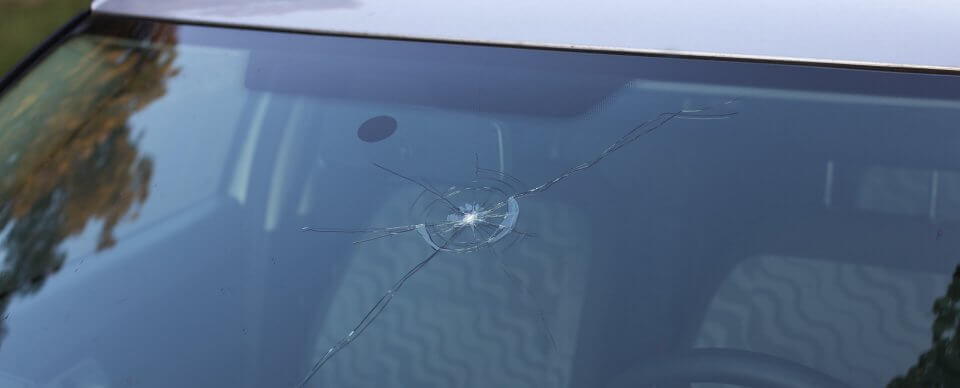
Just about everyone experiences it eventually: driving along on a beautiful sunny day, radio blasting, singing along, and suddenly you hear a crack. A pebble or some other piece of debris flies out from under the tire of the car ahead of you, hitting your windshield dead-center. Whether it causes a tiny chip or a bigger crack, you need to get it fixed. Leaving your windshield with a crack puts you and your passengers at risk. So now you’re wondering, does car insurance cover a cracked windshield?
Let’s take a closer look at whether or not your insurance will cover a cracked windshield, as well as whether it’s better to repair or replace it. And yes, we’ll even go over how to handle a cracked window!
Does Insurance Cover a Cracked Windshield
Even if it’s a tiny crack, you need to get it fixed: they rarely stay small. The good news is that any comprehensive policy should cover auto glass repair or even windshield replacement, as long as the crack was from a covered event. Examples of covered events include:
- Snowstorms, thunderstorms, or other inclement weather
- Natural disasters, like a hurricane or tornado
- Falling objects
- Vandalism or car theft
- Animal damage, like hitting a deer
You’ll also have insurance coverage for a windshield replacement if you have collision coverage and are in an accident. It’s quite common for windshields to be totaled in head-on collisions.
Depending on your policy, windshield repair (rather than a replacement) might not cost you anything, so check with your insurance company or agent before doing anything.
Before filing a claim, of course, you’ll want to be sure it’s worth it. For example, if you have a $500 deductible and the cost to repair your windshield will only be $50, it makes sense to take care of it yourself. Some insurance policies do not require a deductible for windshield repair since costs are usually so low. If you experience a cracked windshield, always refer to your policy before taking action either way.
If you only carry liability insurance, you will have to cover the cost yourself regardless. That’s where a windshield protection plan might come in handy.
Not everyone can afford a full comprehensive policy, or it just might not be worth it if your car is a little older. In these cases, you might consider a windshield protection plan add-on. This is far less than the cost of comprehensive coverage and can give you peace of mind should your windshield ever get a crack.
Does Car Insurance Cover a Windshield Replacement?
What if your windshield is completely totaled and you need a replacement? Does car insurance cover a broken windshield? Luckily, when you have car insurance, a windshield replacement is usually covered as long as it meets certain requirements.
Naturally, your auto insurance will recommend that you first repair any windshield when it’s safe to do so. That’s because it’s usually cheaper than a full replacement.
However, if your windshield has large cracks or has cracks that obstruct the driver’s line of vision, your comprehensive policy or windshield protection plan will cover the costs. Just like with a cracked windshield, you may need to decide whether or not it’s the most cost-effective for you to use insurance or pay out of pocket.
Cost of a Windshield Replacement
The average cost to replace a windshield is $350, according to the National Windshield Repair Division. Unfortunately, though, this range can vary even more than the cost of repairing cracks. Factors that affect the cost of a new windshield include:
- Sensors and other technology. Many newer cars contain important sensors and other technology. These must also be replaced with glass, drastically increasing costs by several hundred dollars. Therefore, you may find it’s cheaper to get replacement glass in your older vehicle.
- Classic cars. That said, not all older cars have cheap windshield replacements. Classic cars may require custom windshields because they aren’t a standard size.
- Tinted glass. Do you want tinted or special glass? If so, this will cost you more than standard auto glass.
- Luxury vehicle. Certain makes, like Mercedes Benz and Lexus, require special glass straight from the manufacturer. This increases the cost of glass.
- Front or back windshield. Usually, it’s your front windshield that takes the brunt of any damage. But if your back windshield needs to be replaced, it can be a little cheaper because you usually don’t have to worry about the wiper assembly.
- OEM glass. Using an aftermarket windshield can greatly lower the cost of a replacement. However, using OEM glass provides higher quality.
Should I Have My Windshield Repaired or Replaced?
You might have been asking yourself, “Does insurance cover a cracked windshield?” Usually, the better question to start with is whether you can repair it at all or if you’ll need auto glass replacement instead.
Luckily, when you call your insurance company to tell them about the issue, they’ll send a professional to take a look at your vehicle. They’ll be able to tell right away whether a repair or replacement would work best for your specific scenario.
In general, cracks that are less than 3 inches in length and don’t obscure the driver’s line of vision can be repaired. Each state may also have its own guidelines about which types of cracks can be repaired without requiring a replacement windshield. But if you’d like a general idea before your technician arrives, here is some information on the different types of cracks and chips your windshield can sustain:
- Stress crack. These typically occur from extreme temperature fluctuations. For example, if your car gets covered in ice during the winter and then warms up in the heat of the sun, you might experience a stress crack. They are more common along the edge of a window because there is no impact point.
- Floater crack. This can be any type of crack that doesn’t extend to the edge of the window. Once a floater crack reaches within 2 inches of the edge of the windshield, you’ll probably need a replacement.
- Crack chip. A crack ship is a small gauge in your window from a rock or other particle. Usually, you’ll notice an impact point with one or more cracks radiating outward. Short cracks are less than 6 inches in length, long cracks are more than 6 inches, and edge cracks extend to the edge of the windshield.
- Star break. This is when the point of impact creates a series of legs that radiate from the break, causing the cracks to go in several directions. While these can usually be filled, you’ll probably still be able to see faint traces of it.
- Bullseye crack. This unique formation has a cone in the outer layer of glass that creates a darker circle where the impact took place. Unfortunately, these types of cracks are harder to repair, so you may need a windshield replacement if this happens to you.
- Combination crack. A combination crack is just like it sounds — a mix of one or more of the types of cracks and chips listed above. Having multiple cracks can make the windshield harder to repair, so you’ll usually need a replacement in this instance.
Repairing the glass will always cost less than replacement. If you’re paying out of pocket, you’ll most likely want to use the less expensive option. If your insurance covers it, they’ll probably be the ones to decide whether to repair or replace it. Typically, they’ll go with the least expensive viable option.
Regardless of whether you have your windshield repaired or replaced, the process should only take about 30 minutes. That means you’ll be back on the road in no time!
Does Car Insurance Cover a Broken Window?
As you can see, car insurance is pretty great for covering a cracked or broken windshield. But what about the rest of the windows in your car? While windshields typically suffer the most damage, it’s not unheard of for debris to fly up and crack the glass. You might also have a broken window if you’ve recently suffered a break-in or were in an accident.
Good news! Car insurance has pretty much the same policy when it comes to broken windows. You can rely on your collision coverage to foot the bill if you’re in an accident. And if you have comprehensive coverage, that will cover you if one of the covered events we talked about above were to occur.
What Is The Process of Getting My Windshield Repaired or Replaced?
If you’ve determined that your insurance indeed covers your windshield damage and that filing a claim is your best option, your next step is to contact your insurance company or agent to start the claims process. Depending on your insurance company, you might be able to start the claim online or with a mobile app as well.
You will most likely need to take pictures of the damage and explain what happened. This gives your agent a better idea of what occurred so they can determine if it was a covered event.
After reviewing your evidence, the company will determine whether you do have a valid claim and might suggest a repair shop. Keep in mind that, in most cases, you can choose to use a different repair shop if you prefer. This is usually mandated by law. Still, by using the place your insurance company recommends, you’ll probably receive a negotiated price on your services.
What Does It Cost To Replace a Windshield Without Insurance?
The cost of replacing a windshield without insurance can vary depending on several factors, including the make and model of your vehicle, the type of glass needed, and the labor costs charged by the repair shop.
Keep in mind that this cost may also increase if the damage to your windshield is extensive or if you require additional services, such as recalibrating your vehicle’s advanced driver assistance systems (ADAS) or replacing other auto glass components. It’s always best to shop around and get quotes from multiple repair shops to ensure that you’re getting a fair price for your replacement.
The following factors affect the cost of replacing a damaged windshield without insurance:
Type of vehicle: As we mentioned above, the cost of replacing a damaged windshield can vary depending on the type of vehicle. For example, the cost of replacing a windshield for a luxury car may be more expensive than a regular car.
Type of windshield: There are different types of windshields available, such as tempered glass or laminated glass. The cost of replacing a windshield can vary based on the type of windshield.
Availability of the windshield: If the windshield needs to be ordered, it can increase the cost of replacement. The availability of the windshield can depend on the make and model of the vehicle.
Location of the damage: The location of the damage can affect the cost of replacement. For example, a chip or crack near the edge of the windshield may require a replacement of the entire windshield, which can be more expensive.
Degree of damage: The extent of the damage can also affect the cost of replacement. A small chip or crack can be repaired for a fraction of the cost of a full replacement.
Labor costs: The cost of labor can vary based on the location and the technician’s experience.
Additional services: Some replacement services may include additional services such as cleaning or replacing windshield wipers. These additional services can increase the cost of replacement.
Get a Quote for Insurance To Cover Cracked Windshields
You’ll never have to ask yourself, does insurance cover a cracked windshield? again when you choose an affordable windshield protection plan for your affordable auto insurance from Freeway Insurance. Our windshield protection plans cover minor windshield damage, including chips and cracks up to six inches long. You can visit us at any of our offices or call us at 800-777-5620 and our agents will assist you.



